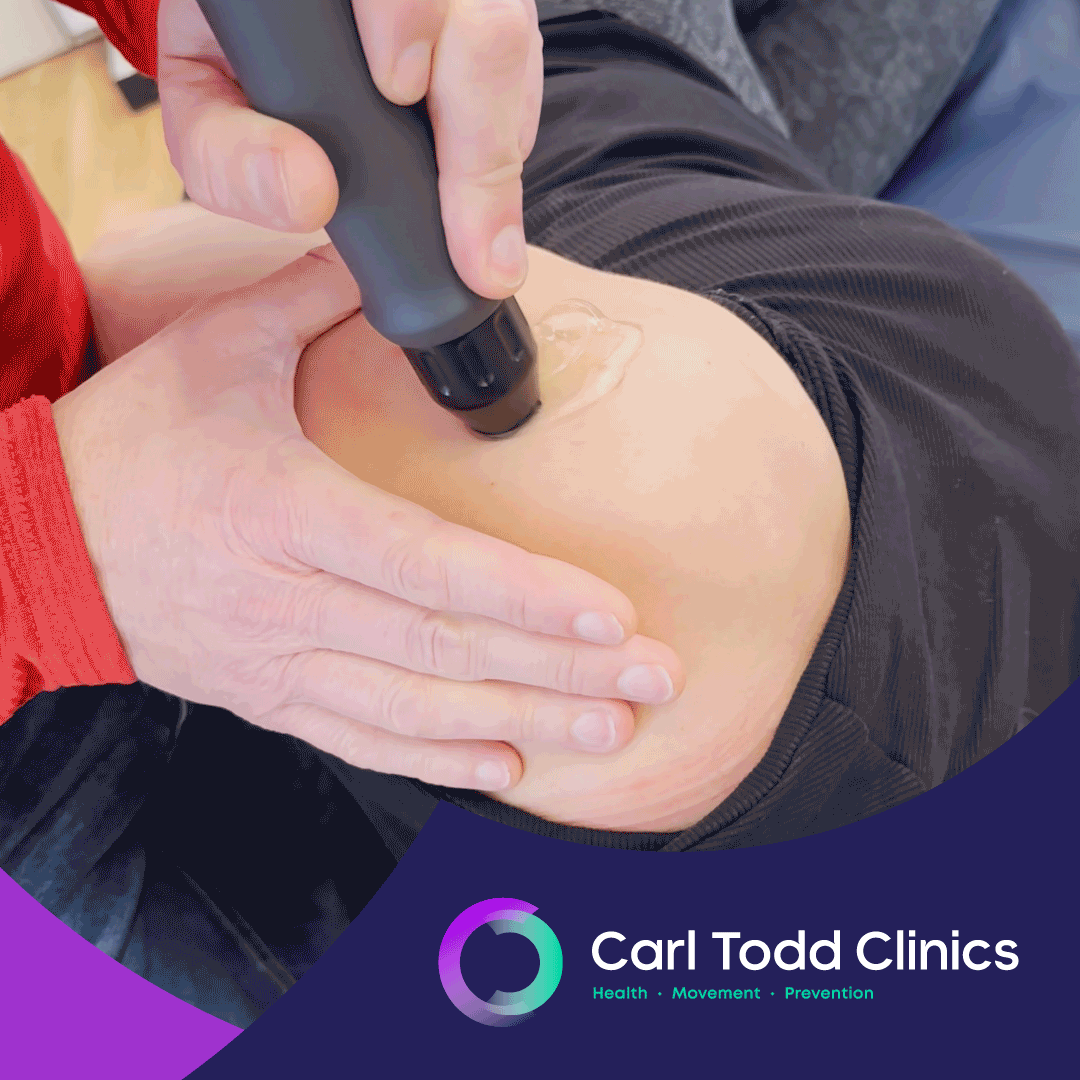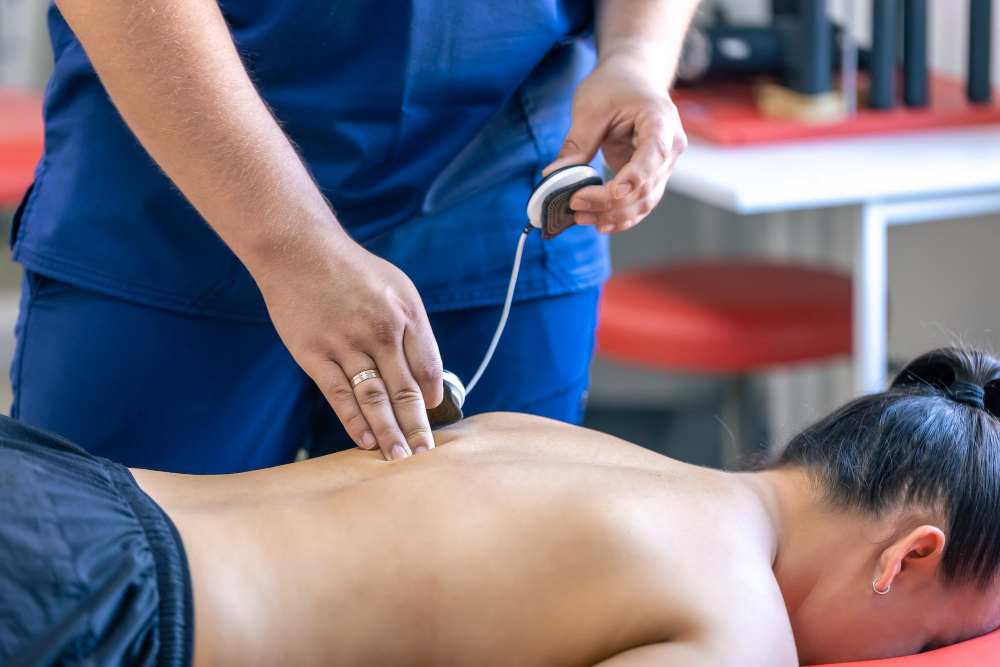Injuries can be both painful and debilitating. One minute you are actively participating in sport, doing some gardening or even just walking, but the next you are in pain and unable to move. Pain relief can help mitigate the symptoms, but does not help to heal and repair the injured joints, muscles, tendons, and ligaments.
What if there was a proven, non-invasive treatment that could help you recover? Something that had been used for nearly thirty years, with a large volume of scientific data to show its effectiveness? A therapy that could be delivered on an outpatient basis that gives significant or total relief of pain in the majority of patients.
Well, there is! Welcome to Shockwave therapy!
What is shockwave therapy?
Shockwave therapy, also known as Extracorporeal Shockwave Therapy (ESWT) or Radial Shockwave Therapy (RSWT) is a non-surgical treatment that targets damaged tissues within an abnormal or damaged tendon. Using targeted sonic ‘shockwaves’, the treatment was originally designed for eliminating kidney stones without causing skin injury, nearly 25 years ago.
A small, handheld device is used to deliver the shockwaves to the injured area. The shockwaves are thought to work by increasing blood flow to the area, which can help to promote healing and reduce pain. Whilst popular in Europe, Shockwave therapy is a relatively novel treatment for musculoskeletal issues in the UK, although it has grown in popularity in recent years.

How does shockwave therapy work?
Despite what you might think from the name, Shockwave therapy uses directed low energy sound waves, rather than electrical waves. These waves radiate through the skin and into the affected muscle, joint or tendon, stimulating blood flow to the area. The combined effect is to create a small amount of localised inflammation.
Your body reacts naturally to the inflammation and in doing so, stimulates the repair and regeneration of cells around the injury, as well as reducing pain. Shockwave therapy also helps to break down scar tissue, which can help increase mobility!
Here’s what you can expect from a shockwave therapy treatment:
- A device delivers sound waves: The technician applies a device to your skin near the injured area. This device generates acoustic waves, which are essentially high-energy sound waves that aren’t electric in nature.
- Waves target tissues: These waves travel through your skin and target the injured tissue.
- Healing response triggered: The sound waves are thought to stimulate your body’s natural healing process in a few ways. They may increase blood flow to the injured area, which can accelerate healing and reduce pain by promoting the delivery of nutrients and oxygen. They might also help break down scar tissue and promote the growth of new, healthy tissue.
- Pain relief possible: In some cases, the shockwaves may also help reduce pain by directly affecting nerve endings in the area.
What is shockwave therapy used for?
Shockwave therapy is mainly used to address chronic pain and promote healing in tendons, ligaments, and other soft tissues. Here are some specific conditions it can target:
- Tendinitis: Shockwave therapy is often used for tendinitis, which is the inflammation of a tendon. the tissue that connects muscles to bones. Common types treated with shockwave therapy include plantar fasciitis (heel pain), Achilles tendinitis (ankle pain), tennis elbow, and golfer’s elbow.
- Calcification: Shockwave therapy can break down calcium deposits that sometimes form in tendons, a condition associated with some tendinitis.
- Other soft tissue injuries: While tendinitis is a frequent target, shockwave therapy may also be used for other soft tissue injuries that haven’t responded well to more conservative treatments.
What conditions is shockwave therapy used for?
Shockwave therapy is an effective treatment for a variety of musculoskeletal conditions. Most commonly these include:
- Plantar fasciitis
- Calcific tendinopathy
- Tennis and Golfer’s elbow
- Shoulder pain
- Proximal Hamstring Tendinopathy
- Patella tendinopathy
- Achilles tendinopathy
- Women holding elbow in pain
Does shockwave therapy really work?
Shockwave therapy works! The National Institute for Health and Care Excellence (NICE) has approved guidelines for its application for the treatment of various tendon-based injuries. Many other scientific papers report the effectiveness of ESWT. A study of 384 patients, suffering from a tendinopathy, published in the US National Center for Biotechnology Information, concluded:
“The pain reduction and the improvement of functionality and quality of life after shockwave treatment increased by at least two points on the five-point Likert scale both post-treatment.”
“Shockwave therapy significantly reduced the pain that accompanies tendinopathies and improves functionality and quality of life. It might be the first choice because of its effectiveness and safety.”
A 2012 meta review of studies which examined extracorporeal shockwave therapy in musculoskeletal disorders, published in the Journal of Orthopaedic Surgery and Research, concluded:
“The success rate ranged from 65% to 91%, and the complications were low and negligible.”
“The vast majority of the published papers showed positive and beneficial effects.”
“ESWT is a novel non-invasive therapeutic modality without surgery or surgical risks, and the clinical application of ESWT steadily increases over the years.”
The evidence is clear, Shockwave therapy works!
Is shockwave therapy available on the NHS?
Shockwave therapy can be available on the NHS but it’s usually not a first-line treatment. This means you’ll likely need to try other conservative treatments like physiotherapy, medication, or orthotics before being considered for shockwave therapy.
You’ll typically need a referral from your GP to a specialist service that offers shockwave therapy. This is usually done when other treatments haven’t provided enough relief, then shockwave therapy becomes a more viable option for NHS coverage.
Here are some resources you can explore to find out more about shockwave therapy availability on the NHS:
- NHS website: The NHS website doesn’t have a central page on shockwave therapy, but you can find information on specific conditions that it may be used to treat. For instance, some NHS trust websites mention shockwave therapy for plantar fasciitis.
- Local NHS trust websites: Each NHS trust has some autonomy over the services it offers. So, check your local NHS trust website for information on shockwave therapy availability in your area.
Overall, while shockwave therapy can be available on the NHS, it depends on your circumstances and local policies. Discuss it with your doctor to see if it’s a suitable option for you and if the NHS might cover it!
Is shockwave therapy suitable for everyone?
Whilst Shockwave therapy is suitable for most people, there are some cases where it may not be applicable. A qualified practitioner will take a full medical history before the start of any treatment, to assess the suitability of ESWT. Some common conditions which may preclude the use of the treatment are:
- Pre-existing health conditions: Shockwave therapy is not recommended for people with certain conditions that could be worsened by the treatment. These are health conditions like:
- Bone cancer: Shockwaves may stimulate cancer cell growth.
- Blood clotting disorders or uncontrolled infections: These conditions increase the risk of bleeding during the procedure.
- Nerve disorders: If you have neuropathy or other nerve issues in the area targeted for treatment, shockwave therapy could cause further discomfort.
- Pregnancy: Shockwave therapy is not recommended during pregnancy due to unknown potential effects on the foetus.
- Localised infection in the treatment area: If you have an active infection near the area targeted for shockwave therapy, it’s important to wait for the infection to clear before proceeding with treatment to minimise the risk of complications.
- Recent steroid treatment for the condition: Steroid injections can weaken tissues, and undergoing shockwave therapy soon after steroid injections could increase the risk of tissue damage.
- Metal pins or implants in the affected area: Shockwaves can potentially interfere with some implanted devices like pacemakers or disrupt the healing process around metal pins used in fractures.
Your practitioner will be able to give specific advice and suggest alternative treatments in these cases.
Is shockwave therapy painful?
Now, when you hear the term ‘shockwave’ you may be thinking ‘Does shockwave therapy hurt?’ But don’t be put off by the name! Whilst you may experience a little pain or discomfort in the affected area, most patients quickly get used to it. Many report ESWT simply feels like small pulses against the skin. For the first few sessions, lower-power acoustic waves can be used, to help a patient acclimatise to the feeling.
Once your session is finished, you can resume your normal daily activities straight away, avoiding high-impact exercise such as running or playing tennis, for the first 48 hours. Paracetamol can be used to manage any pain, however you should avoid taking non-steroidal anti-inflammatory painkillers such as ibuprofen, which can counteract the treatment and render it ineffective. You may experience swelling and redness in the treated area, which is a normal part of the healing process. It should reduce in a few days.
If you’re worried about shockwave therapy pain, here’s a few things to consider:
- Most patients describe the feeling during shockwave therapy as a tingling sensation or small pulses against the skin. It’s generally not described as excruciating pain!
- The level of discomfort can vary depending on the individual’s pain tolerance, the treated area (areas closer to bone tend to be more sensitive), and the intensity settings used during the therapy.
- If you experience significant discomfort during the procedure, let the technician know. They can adjust the settings to make it more tolerable!
- Shockwave therapy sessions typically only last for 5-10 minutes, which helps with managing any discomfort.
- While the treatment itself may not be severely painful, some people experience temporary soreness or tenderness in the treated area for a few hours or up to a day after the session. This is usually mild and shouldn’t significantly impact daily activities.
Shockwave therapy is a well-tolerated procedure for most people. If you’re concerned about pain, talk to your practitioner prior to the appointment!
Would you like to know more about shockwave therapy?
If you have been suffering from tendon pain in your Achilles, knee, elbow, foot, or shoulder for a long period of time and haven’t been able to find relief, then Shockwave therapy may be for you.
If you would like to learn more about shockwave therapy then please get in touch with us and we can talk to you about it. Alternatively, if you would like to book an online appointment you can. We look forward to hearing from you.





